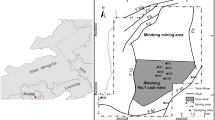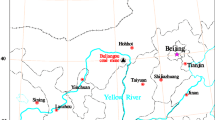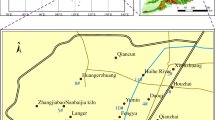Abstract
The occurrence of mine water damage in the process of coal mining and the unknown nature of sudden water source seriously threaten the safety production of coal mine. How to quickly and accurately identify the burst water source has become a hot research topic of mine water damage prevention and control. In order to explore the new identification method of mine water source, taking the working face of 1303 in Shandong Lilou Coal Mine as an example, the main purpose of this study is to accurately identify the source of a large amount of old empty water on the working surface of 1303, point out the direction for water dredging work, and ensure the safety production of coal mine. Fifty-six groups of main aquifer water samples were collected based on groundwater chemical theory and mathematical theory. The contents of water samples Na+, Mg2+, Ca2+, CO32−, HCO3−, SO42−, and Cl−; 7 conventional ions; hydrogen ion concentration (PH); total dissolved solids (TDS), electrical conductance (EC); Cu, Mo, Ba, Ni, Zn, As, and D; and 18O 2 isotopes were determined. The water source system is based on conventional hydrochemical characteristics, fuzzy comprehensive evaluation of trace elements, and isotope analysis. The results show that the conventional water chemical analysis shows that the water sample and the top water in the study area and trace element analysis show that the relative membership of the water sample and the top water is up to 67.25%; isotope analysis shows that the water sample has the same supply source and the ash water varies from other aquifers. Finally, it is determined that the old empty water on the working surface of 1303 of Lilou Coal Mine is mainly derived from the roof sandstone aquifer, which contains a small amount of three ash water and no Austrian ash water. The research results are consistent with the actual mining situation of the mine. The research results provide a new and accurate identification method for mine water source identification and provide a theoretical and technical basis for coal mine safety production.









Source water ratio
Similar content being viewed by others
References
Çadraku H (2021) Groundwater quality assessment for irrigation: case study in the Blinaja river basin. Kosovo Civil Engineering Journal 7(9):1515–1528. https://doi.org/10.28991/cej-2021-03091740
Dinka MO, Loiskandl W, Ndambuki JM (2015) Hydrochemical characterization of various surface water and groundwater resources available in Matahara areas, Fantalle Woreda of Oromiya region. J Hydrol Reg Stud 3:444–456. https://doi.org/10.1016/j.ejrh.2015.02.007
Gao WD (2012) Application of entropy weight fuzzy comprehensive evaluation in identification of mine water inrush source. Mining Safety & Environmental Protection 39(2):22–24
Gao WD, He YD, Li XS (2001) The application of hydrochemical method in mine water inrush source judgment. Mining Safety & Environmental Protection 28(5):44–45
Guo XJ, TangYC XuY, Zhang SS, Ma J, Xiao SB et al (2020) Using stable nitrogen and oxygen isotopes to identify nitrate sources in the Lancang River, upper Mekong. J Environ Manage 274:111197. https://doi.org/10.1016/j.jenvman.2020.111197
Houjian G (2017) Statistical analysis of coal mine water hazard accidents in China 2012–2016. Inner Mongolia Coal Economy 23:107–108. https://doi.org/10.13487/j.cnki.imce.011067
Huang QB, Wang YS, Liu XM (2008) Hydrographic and geochemical characteristics and genetic analysis of Tangdou area. Groundwater 30(6):6–8
Hussain TS, Al-Fatlawi AH (2020) Remove chemical contaminants from potable water by household water treatment system. Civil Engineering Journal 6(8):1534–1546. https://doi.org/10.28991/cej-2020-03091565
Ian DC, Fritz P (2006) Environmental isotopes in hydrogeology. Yellow River Water Press, Zhengzhou, pp P30-33
Ji XL, Xie RT, Hao Y, LuJ, (2017) Quantitative identification of nitrate pollution sources and uncertainty analysis based on dual isotope approach in an agricultural watershed. Environ Pollut 229:586–594. https://doi.org/10.1016/j.envpol.2017.06.100
Ju QD, Hu YB, Zang SY (2018) A study on identification method of mine water inrush source based on principal component analysis and bayesian discriminating method. Coal Engineering 50(12):90–94
Langer P (2020) Groundwater mining in contemporary urban development for European spa towns. Journal of Human, Earth, and Future 1:1–9. https://doi.org/10.28991/HEF-2020-01-01-01
Liu TQ (1995) Influence of mining activities on mine rockmass and control engineering. J China Coal Soc 20(1):1–5
Meng ZP, Li GQ, Xie XT (2012) A geological assessment method of floor water inrush risk and its application. Eng Geol 143–144:51–60. https://doi.org/10.1016/j.enggeo.2012.06.004
Pan GY,Wang SN,Sun XY,Fang SK (2009) Application of isotopic technique in identification of mine water inrush source. Mining Safety & Environmental Protection 36(1):32–34+90.
Piper AM (1944) A graphic procedure in the geochemical interpretation of water-analyses. EOS Trans Am Geophys Union 25(6):27–39. https://doi.org/10.1029/TR025i006p00914
Qu XY, Shi LQ (2018) The identification of mine water inrush source based on Matlab factor analysis and distance discriminating model. Coal Science and Technology 46(08):178–182. https://doi.org/10.13199/j.cnki.cst.2018.08.029
Shen ZL (1986) Hydrographic and geochemical foundations. Geological Publishing House, Beijing
Sun YJ, Yang GY, Zheng L (2007) Based on the GIS of mine water inrush source discrimination system research. Coalfield Geology and Exploration 35(2):34–37
Telci IT, Aral MM (2011) Contaminant source location identification in river networks using water quality monitoring systems for exposure analysis. Water Qual, Expo Health 2(3):205–218
Tripathy DP, Ala CK (2018) Identification of safety hazards in Indian underground coal mines. Journal of Sustainable Mining 17(4):175-l83. https://doi.org/10.1016/j.jsm.2018.07.005
Wang DC, Zang RQ, Shi YH (1995) Hydrogeological fundamentals. Geology Publishing House, Beijing, pp P61-62
Wang XY, Xu T, Hang D (2011) Application of distance discriminance in identifying water inrush resource in similar coalmine. J China Coal Soc 36(8):1354–1358. https://doi.org/10.13225/j.cnki.jccs.2011.08.028
Wang Q, Hu XZ, Zhang XP(2001) The water of the old mining area, fall column and fault is determined by comprehensive geophysical technology. China coal 27(5):29–30+14. https://doi.org/10.19880/j.cnki.ccm.2001.05.009
Wu Q (2014) Progress, problems and prospects of prevention and control technology of mine water and reutilization in China. J China Coal Soc 39(05):795–805. https://doi.org/10.13225/j.cnki.jccs.2014.0478
Xu X, Wang GZ (2016) The application of BP neural network in identification of mine water inrush source. Colliery Engineering 35(7):144–146. https://doi.org/10.13301/j.cnki.ct.2016.07.059
Xue JK (2019) Quantitative analysis of mine water inrush using isotope method. Coal Engineering 51(12):150–153
Yu KL, Yang YS, Zang CP (2007) Application of fuzzy comprehensive evaluation method in discriminating mine water inrush source. Metal Mines 3:47–50
Zadeh LA (1978) Fuzzy sets as a basis for a theory of possibility. Fuzzy Sets and Systems 1(1):3–28. https://doi.org/10.1016/0165-0114(78)90029-5
Zhang RG, Qian JZ, Ma L, Qin H (2009) Application of extension identification method in mine water inrush source discrimination. J China Coal Soc 34(1):33–38
Acknowledgements
The authors would like to thank the workers of the Department of Geology in the Lilou Coal Mine for their field test and data collection.
Funding
This research was financially supported by the National Science Foundation (42002282, 51804184, 41807283) and the Shandong Province Nature Science Fund (ZR2020KE023).
Author information
Authors and Affiliations
Corresponding author
Ethics declarations
Conflict of interest
The authors declare no competing interests.
Additional information
Responsible Editor: Attila Ciner
Rights and permissions
About this article
Cite this article
Wu, H., Zhai, P., Shi, L. et al. Identification of mine water inrush source based on multiple heterogeneous fusion: a case study in Lilou Coal Mine, China. Arab J Geosci 15, 844 (2022). https://doi.org/10.1007/s12517-022-09836-3
Received:
Accepted:
Published:
DOI: https://doi.org/10.1007/s12517-022-09836-3




